Elaeagnus umbellata
Elaeagnus umbellata is known as Japanese silverberry,[1] umbellata oleaster,[2] autumn olive,[1][3] autumn elaeagnus,[3] or spreading oleaster.[3] The species is indigenous to eastern Asia and ranges from the Himalayas eastwards to Japan. It is a hardy, aggressive invasive species able to readily colonize barren land, becoming a troublesome plant in the central and northeastern United States and Europe.[4]
| Elaeagnus umbellata | |
|---|---|
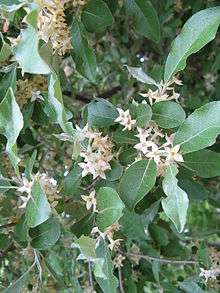 | |
| Scientific classification | |
| Kingdom: | Plantae |
| Clade: | Tracheophytes |
| Clade: | Angiosperms |
| Clade: | Eudicots |
| Clade: | Rosids |
| Order: | Rosales |
| Family: | Elaeagnaceae |
| Genus: | Elaeagnus |
| Species: | E. umbellata |
| Binomial name | |
| Elaeagnus umbellata | |
Description
Elaeagnus umbellata grows as a deciduous shrub or small tree, typically up to 3.5 metres (11 ft) tall, with a dense crown.[4][5] It commonly bears sharp thorns in the form of spur branches.[5] Flowers are fragrant and occur in clusters of white to yellow, 8–9 mm in length and 7 mm in diameter, and have four lobes.[4][5]
The leaves are alternate, 4–10 cm long and 2–4 cm wide with wavy margins. The leaves are covered with minute silvery scales when they emerge early in spring,[5] but turn greener above as the scales wear off during the summer. The underside is more intensely covered in the silvery scales, differing from the related E. angustifolia, which remains silvery until it sheds its leaves in the fall.[4]
Flowers
The flowers are borne in the leaf axils in clusters of 1-7. They are pale yellowish-white, fragrant, (often heavily fragrant) and have a four-lobed corolla 1 cm long.[4] They are an important source of nectar for pollinators such as bees.[6]
Fruit
The fruit is a small round drupe 1/4 to 1/3 inches (0.65 to 0.85 cm) in diameter.[7] The unripe fruit is silvery-scaled and yellow. It ripens to red, dotted with silver or brown. The ripe fruits are pulpy, juicy and sweet, 3–9 mm in length, 5 mm in diameter, and average 137 milligrams in weight, with a thin skin covering the whole fruit.[4][5] Having a sweet and tart flavor, the berries can be eaten fresh or processed for jam, condiments, flavoring, or used as a substitute for tomato.[8] When mature, the red berries contain carotenoids, including considerable amounts of lycopene.[8]
Naturalization
In its origin regions of tropical and temperate Asia, E. umbellata is not considered to be an invasive species, but in many world regions, it has become invasive across wild and cultivated areas, particularly in the eastern United States.[4] In the early 19th century, E. umbellata was purposely introduced to the United States and the United Kingdom for shelter belts, erosion control, wasteland reclamation, wildlife habitat, and for gardens as an ornamental.[4] By the late 20th century, the shrub became a noxious weed and invasive species in many US states from the east coast to the central prairies, and spread widely across Europe.[4]
Due to its substantial seed production and avid germination potential, E. umbellata rapidly invades new areas where it can resprout readily after burning or cutting.[4] Because E. umbellata stands are habitats for wildlife, such as providing forage and shelter for deer, nesting sites for birds, and berries as food for several species,[9] it has been planted for wildlife management in parts of the United States.[4]
In Europe, E. umbellata has spread to the United Kingdom, Belgium, France, and Italy, but has been cultivated in the Netherlands and Scotland.[4] In some parts of North America where it has become naturalized, E. umbellata is considered a noxious weed, particularly in the central and northeastern United States.[4][1] In Canada, it is a "prohibited noxious weed" under the Alberta Weed Control Act 2010.[10]
Because it fixes atmospheric nitrogen in its roots, E. umbellata may grow vigorously and sometimes competitively in infertile soils.[4][11] It can enrich soils and benefit nearby plants, and when grown in orchards, it can increase yields of adjacent fruit trees up to 10%.[12]
Gallery
- Leaves
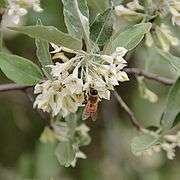 Blossoms
Blossoms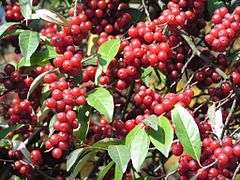 Ripe fruit
Ripe fruit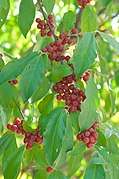 Ripe fruit
Ripe fruit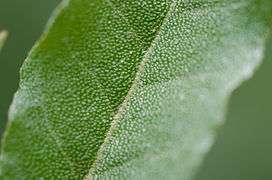 Leaf upperside
Leaf upperside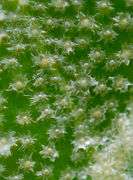 Zoomed view
Zoomed view
References
- Species Profile – Autumn Olive, National Invasive Species Information Center, National Agricultural Library. Lists general information and resources for Elaeagnus umbellata.
- Black B, Fordham I (2007). "Autumn olive: weed or new cash crop?" (PDF). New York Berry News. Retrieved November 1, 2013.
- "Elaeagnus umbellata". Germplasm Resources Information Network (GRIN). Agricultural Research Service (ARS), United States Department of Agriculture (USDA). Retrieved 21 December 2017.
- "Elaeagnus umbellata (autumn olive)". CABI. 6 November 2018. Retrieved 17 August 2019.
- Parmar, C. and M.K. Kaushal. 1982. Elaeagnus umbellata. p. 23–25. In: Wild Fruits. Kalyani Publishers, New Delhi, India. NewCROP, New Crop Resource Online Program, Purdue University
- "Not Pretty Flowers, but Bees Love 'Em — Autumn olive". Michigan state university.
- Dirr, M. 1998. Manual of woody landscape plants : their identification, ornamental characteristics, culture, propagation and uses. Stipes, Champaign, Ill.
- Ingrid M. Fordham, Richard H. Zimmerman, Beverly M. Clevidence, Brent L. Black, Eugene R. Wiley (1998). "Autumn Olive: A Potential Alternative Crop". US Department of Agriculture. Retrieved 10 February 2018.CS1 maint: uses authors parameter (link)
- "Autumn Olive". Illinois wildflowers.
- "Prohibited Noxious Weeds" (PDF). Alberta Weed Control Act, Government of Alberta. 2012. Retrieved 8 February 2018.
- J.R. Clark, G.E. Hemery, and P.S. Savill. Early growth and form of common walnut (Juglans regia L.) in mixture with tree and shrub nurse species in southern England. Forestry (2008) 81 (5): 631-644 first published online September 5, 2008 doi:10.1093/forestry/cpn036
- "Elaeagnus umbellata". PFAF.
External links

- Elaeagnus umbellata images; Bioimages from Vanderbilt University, Nashville, TN, USA
- Species Profile - Autumn Olive (Elaeagnus umbellata), National Invasive Species Information Center, United States National Agricultural Library.